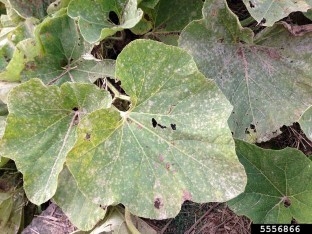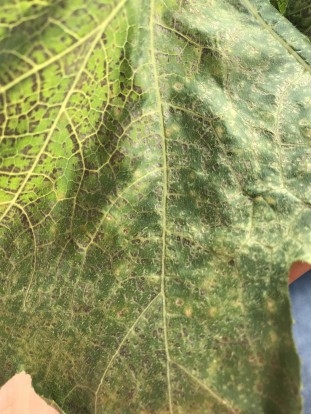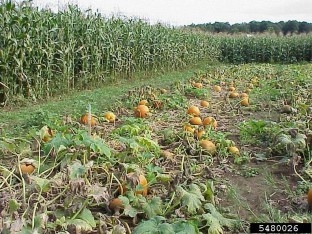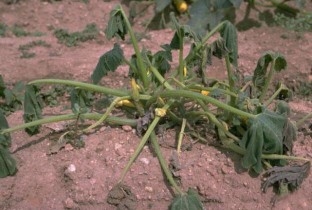Most Troublesome Pumpkin Diseases in Virginia
ID
SPES-140NP
Disease is one of the biggest issues that producers face when growing pumpkins. The three biggest disease challenges for Virginia pumpkin growers are powdery mildew, downy mildew, and Phytophthora crown and fruit rot.
Powdery Mildew
Cucurbit powdery mildew is a fungal disease caused by two main organisms, most commonly Podosphaera xanthii and less commonly Erysiphe cichoracearum (McClurg et al., 2003). Many commercial pumpkin cultivars have at least some resistance to the disease. The fungal pathogen can infect leaves, petioles, and stems. The fungus develops first on the crown leaves, then on shaded lower leaves and on leaf undersides. Powdery mildew colonies can occur on the upper and lower sides of leaves, often with yellow spots opposite the colonies (figure 1). The infected leaves normally wither and die, which can then cause premature ripening of the fruit or the fruit may become sunburnt due to lack of protection from the leaves. It can also decrease storability in winter squash, lead to poor flavor in melons, and poor rind color and shriveled handles in pumpkins. The stress on the plant from powdery mildew can lead to more diseases (McGrath, 2017).

The fungus is believed to be airborne from other infected crops- starting in the southern states where cucurbits are grown earlier in the season. The fungus can remain viable for 7-8 days, but cannot survive without some sort of host (McGrath, 2017).
Powdery mildew can develop very quickly under favorable conditions, with the length of time between infection and visible symptoms being as quick as three days. Dense plant growth, low light, low air movement, high relative humidity, and temperatures of 68°F to 80°F favor rapid powdery mildew development. However, there must be dryness for the fungus to colonize, sporulate, and disperse, and excessive rain and/or moisture on the plants is not favorable for disease development. Temperatures over 100° F can halt the development of powdery mildew. Many plants do not become infected until after there is fruit set on the plant (McGrath, 2017). In the Mid-Atlantic region, disease generally occurs in the crop from mid- July until the end of the growing season (Wyenandt, 2019).
For chemical control, fungicides should be applied every seven to ten days once the fungus is detected on the plants. However, best control of powdery mildew is achieved by protecting the foliage prior to disease appearance. Plants should be scouted very closely once fruit set begins as that is when the plants are more susceptible. With a recommended preventative schedule, spraying should begin when female flowers begin to open or as soon as symptoms are observed in the field (Wyenandt, 2019). For the best control, fungicide sprays need to contact both the underside of leaves and penetrate the leaf canopy. Increased spray volumes, air assisted sprayers, and smaller droplet size can increase the coverage of fungicide sprays on plants. The fungicide label will list specific recommendations for spray volume and sprayer PSI (Wyenandt, 2019).
Pumpkin varieties are now being developed and sold by their resistance level to powdery mildew, so cultivar selection is the first option to assist growers in decreasing the amount of powdery mildew that may affect their crop.
Downy Mildew
Downy mildew is a cucurbit disease caused by the fungal-like oomycete pathogen Pseudoperonospora cubensis. The pathogen moves from the southern United States (where it can overwinter) northward into our area throughout the growing season. Symptoms may vary depending on how quickly the plants are infected. Upper surfaces of the leaves can show angular pale green areas bounded by leaf veins which then change to yellow spots and become necrotic (figure 2). In moist environments, sporulation occurs on the lower leaf surface with yellow, necrotic sections on the upper side of the leaf directly above the sporulation. The patches on the undersides of the leaves can appear to be gray and “downy” (Quesada-Ocampo, 2019).

The spores can be wind-borne and can survive over long distances if the air is moist. They are also easily spread to other plants by splashing water. Downy mildew is usually considered a cool, wet weather disease; however, it can also be spread and infect plants over a 50°F to 80°F degree range. The optimum temperature range for sporulation 61°F to 72°F. If there is heavy dew in the morning, that can be enough for infection to occur. High relative humidity, overhead irrigation, or persistent rain can provide ideal conditions and result in severe damage (figure 3). The pathogen needs a host to survive and it can only overwinter on plants in sites with warm weather, such as the southern US and greenhouses (Quesada-Ocampo, 2019).

Host resistance and other cultural practices are generally ineffective for downy mildew management. Fungicides are required to control downy mildew in pumpkin production and care must be taken to apply fungicides before downy mildew is seen in the field (Wyenandt, 2019). Growers can track the progress of downy mildew by using the Cucurbit Downy Mildew IPM Pipe website (http://cdm.ipmpipe.org).
Phytophthora Crown and Fruit Rot
This multi-symptom pumpkin disease is caused by the oomycete Phytophthora capsici. Seedling damping-off, leaf spots, foliar blight, root and crown rot, stem lesions, and fruit rot are among the potential issues. Leaf spots can be dark brown and large. If crowns are infected, the plant can die in a very short period of time. When the vine is affected, the tissue becomes brown, appears water soaked, and often collapses (figure 4) (McGrath, 2018).

Fruit rot normally starts where the fruit has contact with the ground. It can start as either a water soaked spot that could have fungal growth or could be a depressed spot in the fruit that are very soft and easily punctured. If the vine is infected, the symptoms can also begin around the stem area. The pathogen produces a white, yeast-like growth, especially under moist conditions (McGrath, 2018).
The pathogen can survive in the soil for more than two years between crops. If oospores are produced, the fungus can last even longer in the soil. For the disease to occur, there must be adequate soil moisture and soil temperature above 65°F (McGrath, 2018). Growers can utilize cultural control methods to decrease incidence of Phytophthora in their fields. They can attempt to use fields where Phytophthora has never occurred before, observe at least a 3-year crop rotation, use well-drained fields, and separate plantings of susceptible crops. Pumpkin cultivars with a harder rind may be less susceptible to the Phytophthora fruit rot. Good sanitation practices such as cleaning equipment between fields, wearing clean clothes and shoes between fields if there are multiple crops that may have an outbreak, and being careful with irrigation practices can also decrease the likelihood of infection. (Wyenandt, 2019).
Fungicide Resistance
Unfortunately, for many pathogens, growers have to deal with fungicide resistance development. Common fungicides that growers have used for years are not as effective when used consistently. Fungicide use in pumpkin production is essential because diseases like powdery and downy mildew can cause severe crop losses due to a decrease in photosynthesis in the plant. Overuse of one fungicide can lead to resistant strains of that pathogen, such as powdery mildew populations resistant to benzimidazole carbamates and quinone outside inhibitors (Barickman et. al., 2017).
Good integrated pest management practices and cultural practices are essential in preventing fungicide resistance development. Crop rotations of at least three years between pumpkin or cucurbit plantings are ideal, using well drained fields, cleaning shoes and clothes between fields if the grower knows that there is a current disease outbreak on the farm, not using overhead irrigation, not irrigating at night, removing infected fruit from the field, and using cultivars that have known disease resistance are all essential in preventing fungicide resistance in diseases ((Barickman et. al., 2017). Using cover crops and no-till production methods can also decrease disease pressure within a field. A study in Maryland showed pumpkins planted into a cover crop of hairy vetch and hairy vetch plus rye had reduced Plectosporium blight severity and a decrease in powdery mildew severity when compared with pumpkins on conventional tillage and bare ground production systems (Everts, 2002).
Biofungicides may be an option, particularly for organic producers, but the efficacy of many of these fungicides have not been evaluated (Barickman et. al., 2017).
Choosing a Chemical Control for Pumpkin Diseases
Extension recommendations are updated annually according to product registration changes, label changes, and other factors. As a result, specific recommendations and product rates for use on pumpkins are listed in the Mid Atlantic Commercial Vegetable Production Recommendations (Publication 456-420) which can be accessed through your local Virginia Cooperative Extension agent or by visiting www.ext.vt.edu
References
Barickman, T.C., Horgan, T.E., Wilson, J.C. 2017. Efficacy of fungicide applications and powdery mildew resistance in three pumpkin cultivars. J. Crop Protection. 101(2017) 90-94.
McClurg, C.A., Reiners, S., Riggs, D.I.M., and Rouse, R. (2003). Cultural practices. Pumpkin Production Guide. NRAES-123. Ithaca, NY: Natural Resource, Agriculture, and Engineering Service, 28-42.
McGrath, M.T. 2018. Phytophthora Blight of Cucurbits. Vegetable MD Online. Ithaca, NY.
McGrath, M.T. 2017. Vegetable Crops: Powdery Mildew of Cucurbits. Vegetable MD Online. Cornell University, Ithaca, NY.
Quesada-Ocampo, L. 2019. Cucurbit Powdery Mildew. Raleigh, North Carolina: North Carolina State Extension Publications.
Wyenandt, C.A. 2019. Mid Atlantic Commercial Vegetable Production Recommendations. Virginia Cooperative Extension Pub. No. 456-420. Virginia Tech. Blacksburg, VA.
Virginia Cooperative Extension materials are available for public use, reprint, or citation without further permission, provided the use includes credit to the author and to Virginia Cooperative Extension, Virginia Tech, and Virginia State University.
Virginia Cooperative Extension is a partnership of Virginia Tech, Virginia State University, the U.S. Department of Agriculture (USDA), and local governments, and is an equal opportunity employer. For the full non-discrimination statement, please visit ext.vt.edu/accessibility.
Publication Date
May 7, 2024



